#Performance.Car
Explore tagged Tumblr posts
Video
038 Aston Martin DB5 Vantage (1964) EMU 5 by Robert Knight Via Flickr: Aston Martin DB5 Vantage (1964-65) Engine 3995cc S6 DOC 325bhpProduction 1059 Registration Number EMU 5 ASTON MARTIN ALBUM www.flickr.com/photos/45676495@N05/sets/72157623759800132... The Aston Martin DB5 is a British luxury grand tourer that was made by Aston Martin and designed by Federico Formenti of Italian coachbuilder Carrozzeria Touring Superleggera. Released in 1963, it can be seen as an evolution of the final series of DB4. The principal differences between the DB4 Series V and the DB5 are the all-aluminium engine, enlarged from 3.7 litres to 4.0 litres, and fed by triple carburettors, it produced 282bhp; a new ZF five-speed transmission which was more robust than the earlier David Brown unit. At the beginning, the original four-speed manual gearbox (with optional overdrive) was standard fitment, but it was soon dropped in favour of the ZF five-speed box a three-speed Borg-Warner DG automatic transmission was also available, which was changed in favour of a Borg-Warner Model 8 shortly before the DB6 replaced the DB5 When new the standard Aston Martin DB5 sold for £ 4,248, which at the time was around the price of a semidetached house in a desirable borough The high-performance DB5 Vantage was introduced in 1964. It featured three Weber carburettors and revised camshaft profiles and the engine output upped to 325bhp. 65 DB5 Vantage coupés were built. 123 convertible DB5s were produced (also with bodies by Touring), though they did not use the 'Volante' name until 1965 The DB5 will always be remembered as James Bonds cars, EON productions, to be modified by special effects expert John Stears for use by James Bond in the 1964 film Goldfinger. The original novel by Ian Fleming had Bond driving an Aston Martin DB Mark III. There were a total of four Goldfinger DB5s. There were a total of four Goldfinger DB5s. Two of these were used in filming and two were used only for promotional purposes. The first filming car, DP/2161/1, was fitted with gadgets, it had been the original DB5 prototype car which had made an earlier screen performance in the hands of Roger Moore during episode 2.17, of The Saint - The Noble Scotsman before its appearance in Goldfinger, The same car (registration BMT 216A) was used again in the next film, Thunderball, a year later, it later appeared, minus gadgets in the film The Cannonball Run (1981), once again driven by Roger Moore. Diolch am 92,347,630 o olygfeydd anhygoel, mae pob un yn cael ei werthfawrogi'n fawr. Thanks for 92,347,630 amazing views, every one is greatly appreciated. Shot 23.04.2022 at the Bicester Spring Scramble, Bicester, Oxfordshire 158-038
#Aston.Martin#British#1960s#1964#Aston.Martin.DB5#Aston.Martin.DB6#Vantage#Frederico.Formenti#Carrozzeria.Touring#Superleggra#James.Bond#Goldfinger#Thunderball#Bicester.April.2022#EMU5#Fast.car#Performance.Car#Executive.Express#Swinging.Sixties#1945-70#Auto#Automobile#Car#cars#Classic#Motor#worldcars#flickr
44 notes
·
View notes
Text
Price: [price_with_discount] (as of [price_update_date] - Details) [ad_1] Fitness Scout Cycle Pump, High-Pressure Deluxe, Strong Steel Air Pump for Bicycle, Car, Ball, Motorcycle | Inflatable Air Pump, Floor Air Pumps | Pack of 1 The Fitness Scout High-Pressure Deluxe Cycle Pump is the ultimate solution for all your inflation needs. Crafted with strong steel construction, this floor air pump is built to last and offers excellent performance for bicycles, motorcycles, cars, and even sports balls. With its high-pressure capacity and easy-to-use design, this pump is an essential tool for anyone looking to keep their tires properly inflated and ready to roll. Whether you're on a long bike ride, preparing for a road trip, or simply maintaining your car or ball inflations, this deluxe air pump ensures quick and efficient inflation. It’s the perfect companion for anyone needing a reliable, versatile pump to tackle a variety of inflating tasks at home or on the go. Key Features: Heavy-Duty Steel Construction: Built with a strong steel frame, the Fitness Scout Cycle Pump offers durability and long-lasting performance, ensuring you get years of use. High-Pressure Capacity: Designed to handle high pressure, this pump can easily inflate a wide range of items, from bicycles and motorcycles to cars and sports balls. Versatile Inflating Tool: The pump is suitable for bikes, motorcycles, cars, sports balls, footballs, basketballs, and more, making it a truly versatile inflation device. Efficient & Fast Inflation: Inflate your tires or sports equipment quickly and effortlessly, saving you time and effort, especially in urgent situations. Easy-to-Use: Featuring a user-friendly design, the pump is simple to operate, even for beginners. It includes a wide base for stability during use and a comfortable grip for a secure hold. Floor Pump Design: The floor-standing pump design allows you to use your body weight for better leverage and easier pumping, reducing the strain on your hands and arms. Accurate Pressure Gauge: Equipped with an integrated pressure gauge, it allows you to monitor and adjust the pressure accurately, ensuring the perfect inflation for any item. Compact & Portable: Despite its heavy-duty construction, the Fitness Scout Cycle Pump is compact and portable, making it easy to store and take with you wherever you go. Multiple Nozzle Adapters: Comes with different nozzle adapters to accommodate a variety of valve types, ensuring compatibility with different tires, sports balls, and inflatable products. Ideal for Home or Travel Use: Perfect for use at home, in the garage, or on the go, ensuring you always have the tools needed for quick inflation wherever you are. Applications: Bicycle Tires: Perfect for maintaining the proper tire pressure for smoother and safer rides.Motorcycle Tires: Ensure your motorcycle tires are properly inflated to prevent accidents and ensure optimal performance.Car Tires: Maintain your car tire pressure to enhance safety, fuel efficiency, and overall tire lifespan.Sports Balls: Easily inflate your basketball, football, soccer ball, or other sports balls to the perfect pressure.Inflatables: Ideal for inflating a variety of inflatable items such as pool toys, air mattresses, and more. Heavy-Duty Steel Construction: Durable and built to last, ensuring long-term use for various inflation needs. High-Pressure Capacity: Perfect for inflating bicycles, motorcycles, cars, and sports balls with ease. Efficient & Fast Inflation: Inflate tires and equipment quickly, saving time and effort. User-Friendly Design: Simple to use with a comfortable grip and wide base for stability during operation. Floor Pump Design: Provides easy leverage by using your body weight for effortless pumping. Accurate Pressure Gauge: Built-in gauge for precise pressure control, ensuring accurate inflation. Versatile Nozzle Adapters: Includes multiple nozzle types for compatibility with various valve types. Compact & Portable: Easy to store and carry, perfect for home use or on-the-go.
Ideal for Home or Travel Use: Great for maintaining tire pressure, inflating sports balls, and more. Multi-Purpose Tool: Suitable for inflating bicycles, cars, motorcycles, foot pumps, and sports balls like footballs and basketballs. [ad_2]
0 notes
Text
Car Service in Reading: Keeping Your Vehicle Running Smoothly

Whether you are a car enthusiast or just someone who is predicated on their car for normal commuting, having a reliable vehicle provider is important to keeps your automobile running smoothly. In Reading, a city recognized for its historic significance and bustling city lifestyles, locating a sincere car repair carrier will become an essential task. In this text, we are able to delve into the world of car carrier, restore, and car mechanics Reading.
Introduction
Owning a vehicle comes with the responsibility of its maintenance. A properly-maintained automobile not only ensures your protection but additionally complements its sturdiness and performance.Car service in reading Centers play an important role in offering professional care in your automobile, ensuring it stays in pinnacle-notch condition.
Importance of Regular Car Maintenance
Regular protection is the cornerstone of preserving your automobile in greatest situation. Scheduled oil adjustments, tire rotations, brake inspections, and fluid assessments can prevent capacity issues from turning into essential troubles. This exercise not best saves you cash in the end however also maintains you secure on the road.
Key Services Offered by way of Car Repair Shops
Car restore shops provide various services, from routine upkeep to complex upkeep. Services encompass engine diagnostics, transmission repairs, brake replacements, and greater. These services are designed to deal with precise issues and hold the overall health of your vehicle.
Choosing the Right Car Mechanic in Reading
Selecting a dependable vehicle mechanic can be daunting. Look for certifications, revel in, and customer opinions. A skilled mechanic knows your vehicle's wishes and gives effective solutions.
Understanding Common Car Problems
From ordinary noises to warning lighting fixtures, cars often exhibit signs of hassle. Identifying those symptoms and addressing them promptly can save you minor troubles from escalating.
Signs Your Car Needs Immediate Attention
Certain signs and symptoms, such as smoke from the exhaust, grinding brakes, or steerage troubles, call for immediately interest. Ignoring those signs can cause severe harm and compromise your safety.
DIY vs. Professional Repairs: Which to Choose?
While DIY upkeep might be tempting, complicated issues are high-quality left to professionals. Professional mechanics own the information and equipment to diagnose and fix issues accurately.
The Evolution of Car Repair Industry
The car repair industry has developed extensively, incorporating advanced technologies and diagnostic tools. This evolution has brought about greater green and accurate maintenance.
The Role of Technology in Modern Car Services
Modern motors are geared up with superior technology, requiring mechanics to stay updated with the modern developments. Computerized diagnostics and electronic upkeep are actually commonplace.
Eco-Friendly Practices in Car Maintenance
Many automobile carrier facilities are adopting eco-friendly practices, along with recycling and right disposal of fluids. This shifts in the direction of sustainability blessings each the surroundings and the network.
The Future of Car Servicing
The future holds exciting possibilities for automobile servicing. With electric cars turning into and AI-assisted diagnostics at the upward thrust, the industry is on the brink of transformation.
Factors Influencing Car Repair Costs
Car restore charges can range widely primarily based on factors inclusive of the kind of repair, automobile make, and location. It's crucial to obtain more than one fees and apprehend the breakdown of prices.
Comparing Dealership Services and Local Workshops
Car owners regularly face the selection between dealership services and nearby workshops. While dealerships offer brand-precise information, neighborhood workshops offer customized carrier at a probably lower cost.
Customer Reviews: A Window into Service Quality
Before selecting automobile provider middle, bear in mind studying purchaser reviews. Reviews offer insights into the high-quality of service, client pleasure, and standard reputation.
Conclusion
In conclusion, a nicely-maintained car is important for a safe and exciting using revel in. Regular protection and well timed upkeep now not best enlarge your automobile's life however also prevent from unexpected breakdowns. As the auto provider industry keeps enhancing, embracing generation and eco-friendly practices, car proprietors in Reading have an array of options to ensure their automobiles live in top condition.
1 note
·
View note
Text
The Chevrolet Corvette's Complete History, From C1 to C8


1953: Humble BeginningsChevrolet rushes the Corvette into production following the model's debut at GM's 1953 Motorama show. The two-seat roadster uses fiberglass body panels and relies on Chevy's tried-and-true Blue Flame inline-six for motivation. While the six-cylinder powerplant produces 115 horses in Chevy's sedan, the bow-tie brand tunes the engine to make 150 ponies in the Corvette. A two-speed automatic is the only transmission offered, and all of the cars are painted Polo White and wear a red interior. Chevrolet produces 300 Corvettes in 1953 and sells just 183 of them. Assign blame to the vehicle being neither civilized enough to be a true grand tourer nor engaging enough to appeal to the sports-car crowd.Car and Driver

1954–1955: Find Me in Saint LouisThe first few Corvettes are produced on a small assembly line in Flint, Michigan. However, by the end of 1953, Chevrolet moves production of its sports car to Saint Louis, Missouri. The 1954 Corvette adds three new paint colors (black, red, and blue) and trades the previous black top for a tan one. A revised camshaft adds five horses to the six-cylinder engine's stable. Despite these improvements, Chevrolet still struggles to sell the Corvette. While the Saint Louis factory is capable of producing 10,000 Corvettes per year, it yields just 3640 units for 1954. Car and Driver

1954–1955: Find Me in Saint LouisNew life comes to the Corvette in 1955, when Chevrolet finally shoves its 4.3-liter (265-cubic-inch) V-8 under the model's hood in a fit of good sense. The 195-hp engine brings with it an available three-speed manual transmission. For the first time, the Corvette offers drivers proper sports-car performance.Car and Driver
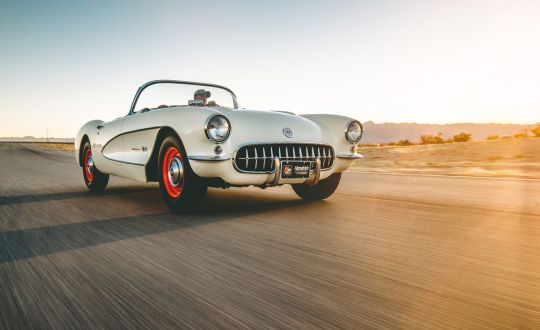
1956–1957: Birth of a LegendChevrolet fully transforms the Corvette for the 1956 model year. A revised front end is reminiscent of the Mercedes-Benz 300SL coupe's, while scalloped sides add a more distinctive look. The V-8 carries over but includes a new camshaft design that allows it to produce 210 horsepower with the standard Carter four-barrel carburetor. A second carb is available and raises output to 225 horses. New creature comforts include external door handles, windows that roll into the door panel (1953 to 1955 Corvettes had removable window curtains), and an available power-operated folding roof. Car and Driver
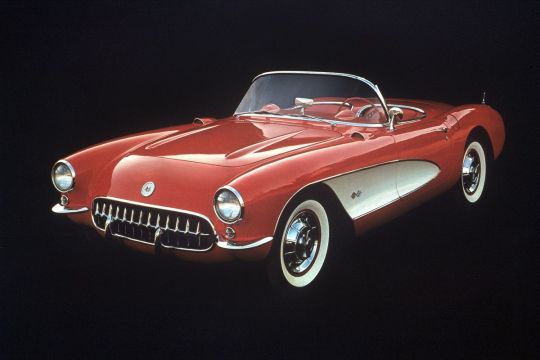
1956–1957: Birth of a LegendWe (still called Sports Cars Illustrated at the time) take an early 1956 Corvette prototype for a spin and find the stick-shift 225-hp convertible hits 60 mph in 7.5 seconds—a massive improvement over the old six-cylinder car, which took more than 11 seconds to reach the mile-a-minute mark. Things get even better in 1957, when Chevrolet enlarges the V-8's displacement to 4.6 liters (283 cubic inches) and adds an available fuel-injection system to the menu. In its most powerful state, the engine makes an eye-widening 283 horsepower.Chevrolet
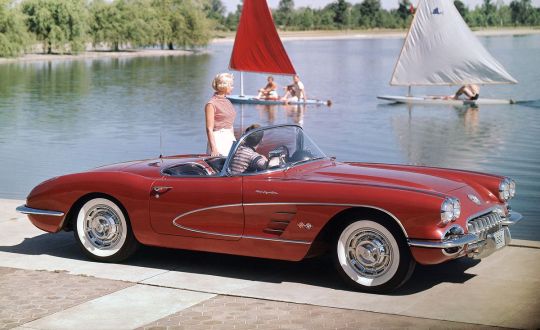
1958–1960: Four for the RoadThe Corvette goes under the knife again and emerges sporting a revised front end with a new dual-headlight design for 1958. Other changes include an updated interior that sees the tachometer move from the center of the dashboard to a location in the driver's line of sight, just below the speedometer. Power continues to rise as well, and the most potent Corvette produces a cool 290 horses from its fuel-injected V-8. That figure rises to 315 ponies for 1960.Car and Driver

1961–1962: Last GoodbyeChevrolet prepares to bid adieu to the first-generation Corvette. A redesigned rear end debuts for 1961 and introduces the sports car's now famous quad-taillight design. Chevrolet shovels its new 5.4-liter (327-cubic-inch) V-8 under the Corvette’s hood in 1962, where it makes as much as 360 horsepower in its highest-rated state.Car and Driver
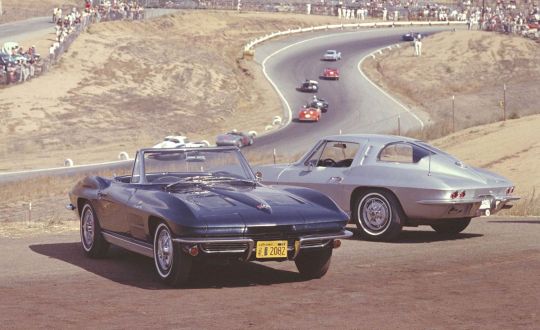
1963: Ray of LightChevrolet releases an all-new Corvette for the 1963 model year. Affectionately known as the Sting Ray, the second-generation Corvette introduces to the model an independent rear suspension and a coupe body style. The form-fitting body is once again made of fiberglass. A split-window design is unique to the first-year coupes. Chevy's 327 V-8 carries over and can be mated to either an automatic transmission or a three- or four-speed manual gearbox. In our test of the then-new Corvette, we chide Chevrolet for offering anything but the four-speed manual in the car. Car and Driver

1963: Z-0-6Knowing the Corvette will appeal to the racing community, Chevrolet offers the model with a race-ready package dubbed Regular Production Order (RPO) Z06. The package adds a vacuum brake booster, a dual master cylinder, power drum brakes with sintered metallic brake linings, larger shock absorbers, and a bigger front anti-roll bar. Limited to Corvettes equipped with the most powerful 360-hp variant of the V-8 engine (250 horses are standard) and a four-speed manual transmission, RPO Z06 is applied to just 199 Corvettes in 1963.Chevrolet
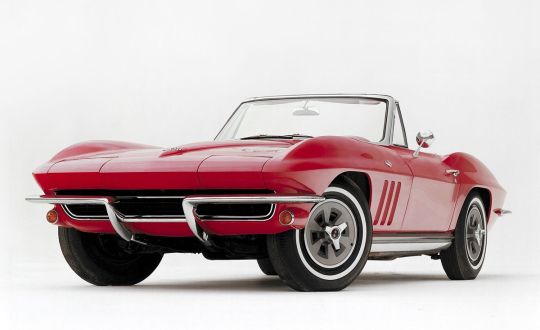
1965: Bigger Is BetterChevrolet responds to critics of the Corvette's drum brakes by equipping the car with standard four-wheel disc brakes for the 1965 model year. (Buyers can still opt for drums at a credit of $64.50.) The brake improvements are a timely upgrade, as Chevrolet also sees fit to plug its big-block V-8 engine under the Corvette's hood. The optional engine displaces 6.5 liters (396 cubic inches) and produces a monstrous 425 gross horsepower—a figure many suspect is underrated. Car and Driver

1966: (Even) Bigger is (Still) BetterFor 1966, Chevrolet increases the engine's bore, subsequently upping displacement to 7.0 liters (427 cubic inches). The bigger big-block belts out a reported 425 horsepower, with power shooting up to 435 horses for 1967. A second 427 V-8 is added to the Corvette lineup for 1967 as well. Dubbed L88, the top-of-the-line bent-eight produces 430 horses on paper. The real number, however, is closer to 560 horsepower. Just 20 buyers check the box for the beefy L88 engine.Chevrolet

1968–1971: SharknadoAfter five model years, the C2 Corvette is replaced for 1968 by the C3. The new car cribs styling details from designer Larry Shinoda's Mako Shark II concept car. The coupe no longer offers a formal rear storage area. However, the body style now includes removable roof panels. Despite the new shape, the third-generation Corvette's underpinnings are nearly identical to its predecessor's. Powertrains are largely carryover, although a new three-speed automatic transmission replaces the prior two-speed unit. Car and Driver

1968–1971: SharknadoChevrolet reinstates the Stingray name in 1969 (now as one word) and enlarges the stroke of the standard V-8, which brings displacement up to 5.7 liters (350 cubic inches). A new V-8, also displacing 5.7 liters, finds its way under the Corvette's hood in 1970. The engine produces 370 horsepower—70 more than the base powerplant. Chevrolet also strokes the heavier big-block V-8 to 7.4 liters from 7.0 liters. That 454-cubic-inch engine makes 390 horses and is dubbed LS5. Chevrolet

1968–1971: SharknadoPower begins to fall in 1971, as octane requirements are reduced in preparation for the upcoming move to unleaded fuel. A new 425-hp big-block V-8 is introduced under the LS6 banner. We test four different powertrain variants of the sports car and find the entry-level 270-hp model with a three-speed automatic scoots to 60 mph in a reasonable enough 7.1 seconds. Meanwhile, the top-dog LS6 requires just 5.3 seconds to do the same deed.Chevrolet

1973–1976: New Bumper, Who Dis?To meet federal safety standards, the 1973 Corvette sports a new mug with a body-color urethane bumper cover. The cover adds 35 pounds to the car's weight and is able to withstand impacts of up to 5 mph without causing damage to the lights or safety features. Power continues to fall, and the entry-level 1973 Corvette spits out just 190 horsepower. Opting for the most powerful big-block engine brings just 275 horses to the stable. Chevy adds a body-color rear bumper to the Corvette in 1974. The big-block engine is pulled from the 1975 Corvette, as is the convertible body style. Catalytic converters are added, and output of the entry-level 5.7-liter V-8 falls to 165 horsepower, although a 205-hp option is available for those in search of more grunt. At this time, we put a 1975 Corvette up against a gullwinged Bricklin SV-1, finding that both front-engined vehicles lack the "essential ingredients of a modern high-performance car." Car and Driver
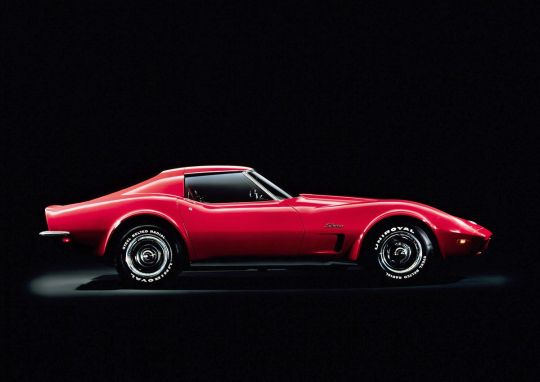
1973–1976: New Bumper, Who Dis?Model year 1976 introduces a revised intake that raises power to 180 and 210 horses, respectively. The Corvette tops a Dodge Dart Sport, Pontiac Firebird Trans Am, Chevrolet C-10 Silverado, and Ford Mustang II Cobra II in a comparison test and earns its standing as the fastest American car sold in 1976. We also take a Corvette to Alaska and toward the Northwest Passage during the U.S.'s bicentennial year. The drive is grueling, and the car's chunky aftermarket tires proceed to spew mud across the Corvette's body, leaving behind "the scars of its confrontation with a world that nobody had ever designed a Stingray for."Chevrolet

1978–1982: Big BootyChevrolet celebrates the Corvette's 25th anniversary by equipping the 1978 model with a new fastback rear end. Although the large glass area placed on the rear of the Corvette does not open, it does make possible a formal rear luggage area behind the seats. Chevy enlists the 1978 Corvette to pace the Indy 500, which results in the production of 300 replica pace car Corvettes. Car and Driver
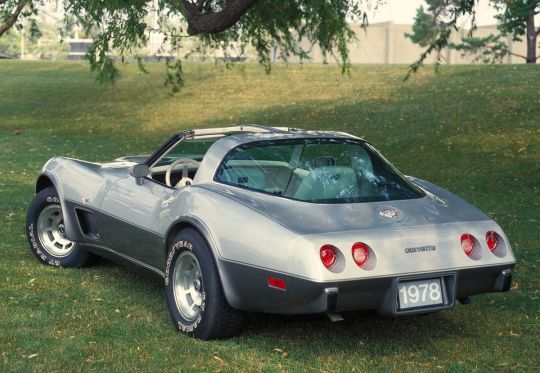
1978–1982: Big BootyThe Corvette adds 5 ponies to its stables in 1979, with the most powerful engine producing 225 horsepower. In our testing, the 3480-pound sports car accelerates to 60 mph in 6.6 seconds and through the quarter-mile in 15.3 seconds at 95 mph. Editor Rich Ceppos calls the car "the most refined ever" and advises Corvette fans to "buy now or forever hold your peace." Despite this advice, the Corvette is anything but perfect, and it falls short of the marks set by the Porsche 924 and Mazda RX-7, which beat it in a six-car comparison test. The Chevy does best an Alfa Romeo Spider Veloce, a Datsun 280ZX, and a Fiat Spider 2000.Chevrolet

1978–1982: Big BootyBy the end of 1981, Corvette production is moved exclusively to the company's new Bowling Green, Kentucky, factory, as the old Saint Louis, Missouri, plant is formally brought offline. The sports car's age is beginning to show, though, and the Corvette finishes last in a five-car comparison test that includes a DeLorean, a Datsun 280ZX Turbo, a Porsche 911 SC, and a Ferrari 308GTSi. Chevy marks 1982 as the third-generation Corvette's final year. The model is a far cry from the car it was in 1968, and the 1982 Corvette is sold strictly with a 200-hp 5.7-liter V-8 mated to a four-speed automatic transmission.Chevrolet

1984–1985: C4 for '84Chevrolet skips model year 1983 and releases the fourth-generation Corvette as a 1984 model. The sports car is redesigned from the ground up and welcomes additional ground clearance but a lower center of gravity. A 205-hp 350-cubic-inch V-8 is the only engine offered and mates to either a four-speed automatic transmission or Chevrolet's four-plus-three manual gearbox, which offers an available overdrive for gears two, three, and four. We find the automatic car is capable of scooting the low-slung coupe to 60 mph in 6.7 seconds and through the quarter-mile in 15.1 seconds at 91 mph. In spite of our love for manual transmissions, we call the self-shifting gearbox "quite a capable tool for generating performance statistics." Car and Driver

1984–1985: C4 for ’84Chevrolet makes a handful of tweaks to the Corvette for 1985, and we subsequently name the model to our third annual 10BestCars list, calling it an "American car that will run with the best in the world—at a fraction of their price." The sports car holds a place on our list through the rest of the decade.Chevrolet
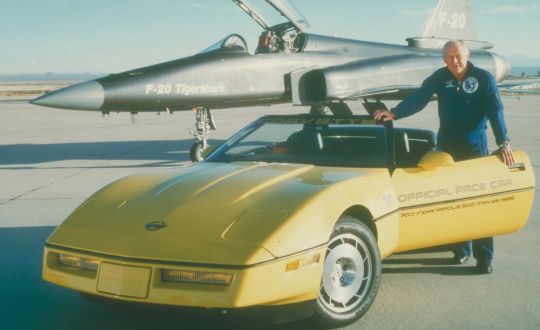
1986: Drop the TopThe convertible returns to the Corvette lineup for 1986. In celebration, Chevrolet drafts the droptop Corvette to pace the 1986 Indianapolis 500.Car and Driver

1990: ZR-#1Chevrolet produces 84 Corvette ZR-1s in 1989, none of which are sold to the public. The ZR-1 finally reaches dealerships in 1990 and is sold through model year 1995. The model boasts a dual-overhead-cam 5.7-liter V-8 engine developed by Lotus and built by Mercury Marine. With 375 horsepower on tap and a ZF-built six-speed manual putting that power to the ground, we push a 1990 ZR-1 to 60 mph in a blistering 4.5 seconds and onto a top speed of 175 mph. To fit its massive 11-inch-wide rear wheels, the ZR-1 wears model-specific doors and rear body panels. We put the mightiest Corvette up against a Porsche 911 Turbo in 1991 and award gold to the American sports car, declaring that the "ZR-1 triumphed over the 911 Turbo for one simple reason: it goes fast better."Car and Driver

1991–1992: Redone for '91Chevrolet lightly revises the Corvette's exterior in 1991. New front and rear fascias and revised side louvers give the car a more modern appearance. A new 5.7-liter V-8 appears under the Corvette's clamshell hood in 1992. Dubbed LT1, the engine produces a comfortable 300 horsepower—50 horses more than the prior L98 engine—and 330 lb-ft of torque. Traction control is standard across the Corvette line. In July, the one-millionth Corvette rolls off the Bowling Green, Kentucky, assembly line. As an ode to the original Corvette, the millionth model is a white convertible with a red interior.Car and Driver
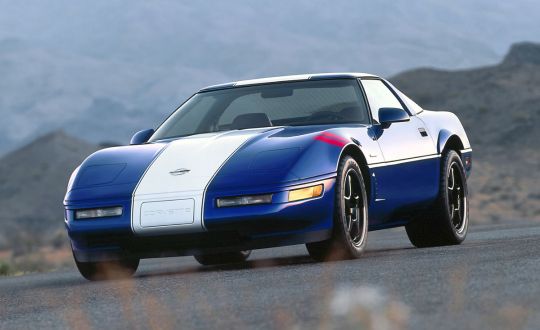
1996: A Grander CorvetteModel year 1996 sees the introduction of the one-year-only LT4 engine. The optional 5.7-liter V-8 produces 330 horsepower and mates exclusively with a six-speed manual transmission. A special Grand Sport model arrives in 1996 as well. The model harks back to the Corvette Grand Sport race cars of the 1960s. Available strictly in Admiral Blue with the more powerful LT4 engine, the Grand Sport is offered as both a coupe and a convertible. The convertible, however, does without the coupe's flared rear fenders.Car and Driver
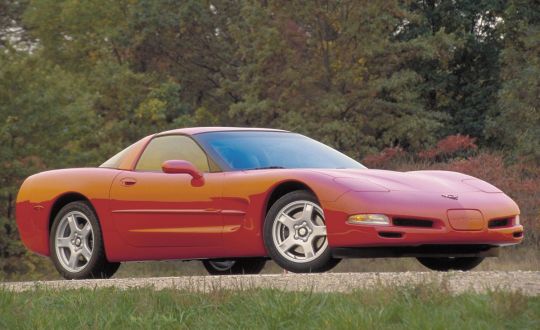
1997: I Got C5 on ItThe fifth-generation Corvette arrives in 1997. Although it evolves the style of its predecessor, the latest Corvette is a completely new animal. Power comes courtesy of Chevy's new LS1 engine. Like the LT1 and LT4 it replaces, the LS1 displaces 5.7 liters. Power now sits at 345 horses, and that output is routed through a four-speed automatic or six-speed manual transmission. Unlike past Corvettes, the fifth-generation model places its transmission at the rear of the car, up against the rear differential. Car and Driver
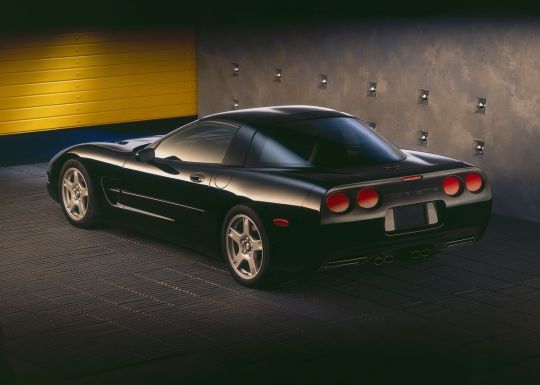
1997: I Got C5 on ItWith a nearly eight-inch-longer wheelbase and a 4.4-inch-wider front track and 2.9-inch-wider rear track, the new Corvette is both more spacious and more stable than its predecessor. It's also lighter than the old car by about 80 pounds. A convertible is introduced in 1998, and the entire Corvette model line reclaims its place on our 10Best Cars list after an absence of almost a decade.Chevrolet
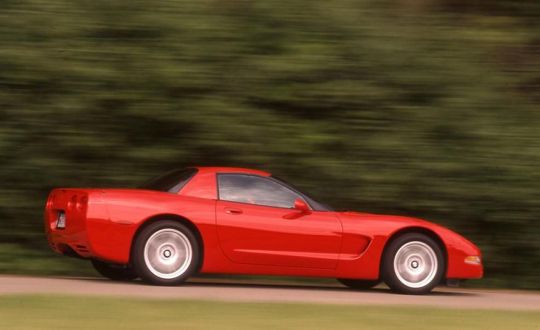
1999: Couped UpChevrolet introduces the Corvette fixed-roof coupe in 1999. The body style complements the targa-topped hatchback and convertible Corvette models. The fixed-roof coupe is approximately 12 percent stiffer than its targa sibling and almost 80 pounds lighter. It's also the least expensive Corvette option and helps the car maintain its spot on our 10Best Cars list, where we declare all three forms of the model "refined, practical sports car with performance that simply can't be matched at the price."Car and Driver

2001: Zee-Oh-SixThe Corvette fixed-roof coupe begets the high-performance Corvette Z06. Introduced in 2001 with 385 horses pouring out of its V-8 engine, the Z06 cribs its name from the famed race-ready option package that Chevy first offered on the 1963 Corvette. Alongside its added power, the Z06 trims its weight relative to the standard Corvette, courtesy of thinner front and rear glass and a set of titanium mufflers. At 3126 pounds, the first Corvette Z06 we test weighs 54 pounds less than the last Corvette fixed-roof coupe to come to our office. Car and Driver

2001: Zee-Oh-SixThe Z06's improved power-to-weight ratio allows it to travel to 60 mph in a mere 4.3 seconds, or half a second quicker than any other fifth-generation Corvette we have previously tested. Chevy outdoes itself the following year and bumps the power of the Z06 to a whopping 405 horses. The addition of the Z06 puts the Corvette back on the 10Best Cars map after a two-year hiatus.Chevrolet

2005: Change (in the House of Flies)The sixth-generation Corvette is unveiled at the 2004 Detroit auto show. The model is, for the most part, an evolution of its predecessor. However, Chevy makes the revolutionary decision to ditch the Corvette's several-generations-running hidden headlights, making the 2005 Corvette the first Corvette in more than four decades to sport exposed front lamps. Although the new Vette is 5.1 inches shorter than its predecessor, the car's wheelbase measures 1.2 inches longer. Car and Driver

2005: Change (in the House of Flies)Chevy revitalizes its LS-series engine by boring it out to 6.0 liters. Known as the LS2, the engine also sports a higher compression ratio, a raised redline, and more. The changes allow the big V-8 to push 400 horses to the rear-mounted gearbox. Transmission choices are once again limited to a four-speed automatic or six-speed manual transmission. We proceed to put the new Corvette to the test by comparing it with its bitter rival, the Porsche 911. We note that the "911 has a tick more sharpness" but ultimately hand gold to the Chevy, which costs nearly $22,000 less than the Porsche. We conclude that "For the money, there isn't a better sports car around ." Chevrolet continues to improve the Corvette over the years and replaces the antiquated four-speed automatic transmission with a new six-speed unit, while the 6.0-liter V-8 sees its displacement rise to 6.2 liters. The changes help the Corvette maintain its status on our 10Best Cars list for the remainder of the decade.Chevrolet

2006: Z06, Part Deux The Corvette Z06 re-emerges in 2006 after a brief hiatus. With the fixed-roof coupe body style killed, the new Z06 is now based on the fastback coupe and sports a lightweight aluminum frame. The model is powered by Chevrolet's latest LS-series engine, the LS7. Displacing 7.0 liters, the V-8 sports titanium connecting rods and produces a mammoth 505 horses. We soon discover all that power helps push the Z06 to 60 mph in a mere 3.4 seconds. While the Chevy bests the Dodge Viper SRT10 in a comparison test, it fails to topple the much pricier Porsche 911 Turbo and Ferrari F430.Car and Driver

2009: Return of the ZR1More than a decade after its demise, the ZR1 returns to the Corvette lineup for the 2009 model year. Unlike the prior twin-cam model, the new ZR1 makes its power courtesy of a big fat supercharger strapped to the top of Chevy's overhead-valve 6.2-liter V-8. The engine makes 638 horsepower and can propel the ZR1 to a top speed of 205 mph. We test the mightiest Corvette against the run-of-the-mill model and the 505-hp Z06 and find the six-figure ZR1 to be "one of those rare cars, such as the Ferrari F430 Scuderia and the BMW M3, that make its driver look more heroic than reality suggests."Car and Driver

2010: Granddaddy SportThe Corvette Grand Sport returns in 2010. The trim level combines the wide-body stance of the Corvette Z06 with the powertrain of the standard Corvette, and it topples a Ford Mustang Shelby GT500 in a comparison test between the two American muscle cars.Car and Driver

2013: Give or Take a Cubic InchTo celebrate the Corvette's 60th anniversary, Chevrolet plugs the Z06's 505-hp engine into the Corvette droptop. The model is called the Corvette 427 convertible, and it is capable of scooting to 60 mph in just 3.9 seconds. The name is a nod to the 427-cubic-inch V-8 offered in earlier Corvette generations as well as to the 7.0-liter V-8 under its hood that actually displaces 428 cubic inches. Don't worry, Chevy; math isn't our strong suit, either.Car and Driver
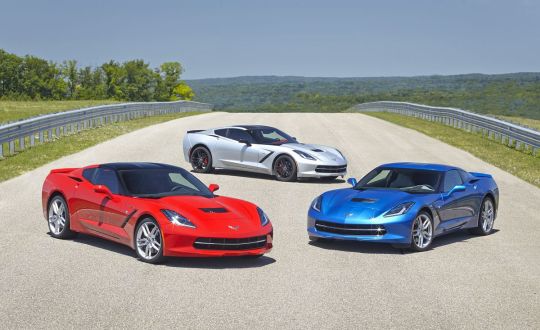
2014: Lucky Number C7Resting on a new aluminum frame, the seventh-generation Corvette arrives in 2014 and marks the model's biggest change in more than a decade. Power comes courtesy of the new LT1 V-8, which displaces 6.2 liters and pushes 455 horses (460 with an optional exhaust) to the ground by way of a six-speed automatic or seven-speed manual transmission. An eight-speed automatic replaces the six-speed unit in 2015. Every Corvette benefits from a carbon-fiber hood, and the model is once again christened Stingray. The Corvette finds its way back onto our 10Best Cars list in 2014 and 2015 but falls off the list in 2016. We test a Corvette Stingray for 40,000 miles and conclude the car is "an amazing performance bargain." Despite our infatuation with our long-term Corvette, we're left kicking dirt when the engine detonates itself at the 6000-mile mark.Car and Driver

2015: King of the HillThe Z06 reappears in 2015 and boasts a supercharged 6.2-liter V-8 engine with 650 horsepower. The mean machine is available as both a coupe and convertible and with either a seven-speed manual or an eight-speed automatic, the latter of which pulls the car to 60 mph in just 3.0 seconds. Meanwhile, a set of sticky Michelin Pilot Sport Cup 2 tires allow the mighty Corvette to stick to our 300-foot skidpad at a hair-raising 1.19 g. Car and Driver

2017: Return to InnocenceThe wide-body Corvette Grand Sport returns for 2017 and provides the Corvette with the necessary push to find a place once again on our annual 10Best Cars list. We promptly order one for a long-term 40,000-mile test.Chris Doane Automotive - Car and Driver

2019: Big Wing BluesChevrolet reintroduces the ZR1 for 2019. The top-dog model makes 755 horsepower from its supercharged 6.2-liter V-8 engine but still manages to earn an EPA-rated 20 mpg highway fuel-economy figure when equipped with the optional eight-speed automatic transmission. A seven-speed manual is standard. We take the big-winged Corvette to the infamous Texas Mile and manage to hit 183.3 miles after traveling a mere 5280 feet.Anton Watts - Car and Driver
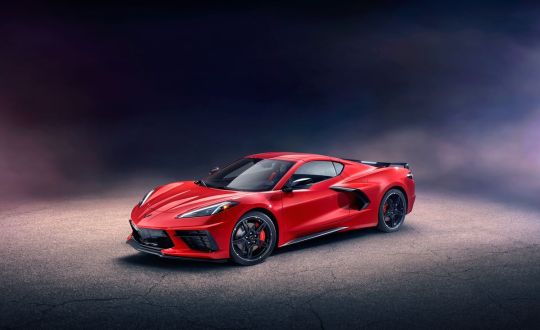
2020: The Corvette Finally Goes for the MiddleThe eighth-generation Corvette, dubbed C8, is the first ever from the factory to situate its engine behind the passenger compartment and ahead of the rear axle. This transition has been decades in the making, and the production car appears impressive—especially given its sub-$60,000 starting price. Chevrolet installs a 6.2-liter "LT2" V-8 in the base Stingray model, pairing it with an all-new eight-speed dual-clutch automatic transmission; no manual transmission is offered. With the Performance exhaust option, the LT2 engine produces 495 horsepower and redlines at 6600 rpm. Greg Pajo - Car and Driver

2020: The Corvette Finally Goes for the MiddleThe C8 Corvette's design is busy, to say the least, but it clearly conveys that America's sports car no longer houses its engine in its nose. Inside, Chevrolet massively stepped up the Corvette's game, with a wholly unique and quality cabin design unlike anything else in the bow-tie lineup.Greg Pajo - Car and Driver


Read the full article
4 notes
·
View notes
Text
TR Light-Weight Running Shoes for Men's-65
TR Light-Weight Running Shoes for Men’s-65
Price: (as of – Details) Shoe Width: MediumElevate your style with this classy pair of Casual Shoes from the house of World wear footwear.NEUTRAL:- For runners who need a balance of flexibility & cushioningAbout product :- The Footwear That Suits Your Personality. Our Footwear Are Made With Good Material And The It Offers You Trendy Design With Long Lasting Performance.Care Instructions:- Rotate…

View On WordPress
0 notes